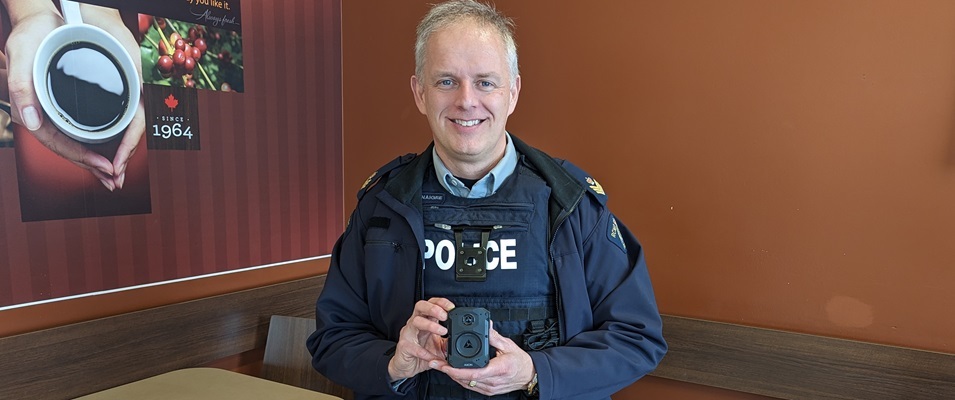
It’s been five months since the machete attack in Niverville which sent one man to hospital and the entire town and neighbouring communities into a state of alarm. Since that time, residents in both Niverville and Ritchot have rallied to beef up their communication, crime education, and prevention measures to aid the St. Pierre RCMP detachment in curbing local crime.
After a lengthy hiatus of the Niverville Citizens on Patrol Program (COPP), a new program was founded and called Niverville Crime Prevention Patrol (NCPP). Thirty residents have signed up for this volunteer program, patrolling the streets nightly.
Niverville resident Barry Piasta has made great efforts to complement this program with a separate one called Connected Community. His program has yet to catch on, but its model is a good one: to return us to times past when neighbours looked out for neighbours. Though this modus operandi came more naturally to neighbourhoods in the old days, Piasta’s vision is to organize it in such a way that the model can be reintroduced.
“A connected community is about bringing the community together,” Piasta says. “This idea is more than just security. It’s about neighbours knowing neighbours, about knowing the people on your block. Kind of like everyone keeps mentioning, ‘Back in the good old days.’ Well, we’re trying to recreate that in a way. We can look after each other. We can know whose vehicle is whose. It’s based on Neighbourhood Watch and Block Parent ideas.”
Ritchot, too, has implemented a new COPP program through Manitoba Public Insurance. So far, volunteers have actively been patrolling Île-des-Chênes and Grande Pointe. The group is still seeking volunteers from St. Adolphe and Ste. Agathe.
Since a big public meeting was orchestrated by Piasta following the machete attack, Niverville’s town council has collaborated with the RCMP to reopen its satellite office in Niverville. According to Sgt. Rheal Gravel of the St. Pierre detachment, service delivery to Niverville and the area has increased.
“It… has helped to obtain better and timely information regarding community policing issues,” says Gravel. “Timely information is the key to successful resolution of community concerns. RCMP members from St. Pierre and Traffic Services regularly use the satellite office.”
Are We Doing Enough?
With all of this change, property crime still takes centre stage on social media platforms. Almost daily, new crimes or suspicious activity is shared. Where last year’s online reports focused on thefts of loose change from unlocked vehicles, today the crimes have escalated to smashed car windows, garage break-ins, home invasions, robberies, and in at least one case an armed attack with a dangerous weapon. According to the St. Pierre RCMP, property crime in Niverville has gone up 45 percent in the first quarter of 2017 since the same period in 2016.
“When I moved to Niverville in 2015, not even two weeks had passed when our cars had been rummaged through in the middle of the night,” says one Niverville resident. “I was naive in thinking crime wouldn’t happen here. It happens everywhere, no matter where you live.”
Earlier this year, this same resident experienced the shock of two attempted home break-ins in one day. First, someone tried to get in through a window while the family was away. Later that night, someone did get in through their garage door while the family was home. Both times the perpetrators were scared off by the family’s home alarm system.
“[I was] scared, of course,” she says. “Afraid to walk into the house and frightened as I’m watching my husband walk outside in the middle of the night when there could be someone in our garage waiting to hurt us.”
Niverville’s new Shell station has also fallen victim to two break-ins in recent months.
“We have owned the Shell in St. Pierre for seven years and [have] never been broken into,” says Sylvie Forest, co-owner of both stations. “The RCMP have been helpful, but they have been swamped. There’s not enough RCMP for [the area]. To be honest, I personally think the first break-in was outsiders but I have reasons to think the second one was someone local. [It] doesn’t look like young kids, either. [Based on security camera footage they’re] all people over the age of at least 35 or 40. It’s very frustrating and I’m not sure what to do or think.”
Forest says that her surveillance camera has also indicated a good number of NCPP patrols monitoring their area, for which she is thankful. But the patrols didn’t spot the crimes which took place at around 3:00 a.m. and 4:00 a.m. on different nights. So far, the perpetrators have been well-disguised and their targeted items have been cash and cigarettes.
“They are fast because they know they don’t have much time,” says Forest. “By the time the alarm company makes their calls, it’s too late. They are gone.”
Since that time, the Forests have installed strobe lights and sirens in the front and rear of their building.
Ritchot COPP coordinator Marianne Curtis says similar incidences are happening regularly in Ritchot as well.
“We have seen an increase of incidents in St. Adolphe, Grande Pointe, and Île-des-Chênes,” says Curtis. “It’s almost like they go in a loop from Winnipeg, down to Niverville, then back [up Highway 59].”
Curtis notes that their COPP volunteers have already had numerous opportunities to report impending or actual crime. In one case, a resident spotted and photographed a young man in a mask in their neighbour’s yard. The man carried a bolt cutter and was rummaging around a tool shed. The neighbour contacted Curtis, who dispatched some available COPP volunteers. With the aid of the photograph, the patrols, and the RCMP, the young man was apprehended.
Curtis adds that mini-storage companies have been hit as well as gas stations in Lorette, Landmark, Île-des-Chênes, Grunthal, and Ste. Anne, all within days of each other.
Population Growth and Crime
“Population growth in the town of Niverville and surrounding areas have had a direct influence on the increase in property offences,” says Sgt. Gravel. “St. Pierre-Jolys RCMP is aware of the impact it has on the community and have made significant arrests and continue to conduct proactive and preventative patrols.”
Gravel believes, based on his detachment’s findings, that much of the crime seems to be internal and Niverville is not necessarily being targeted by outside criminals.
“Recently, several arrests by the St. Pierre members regarding property crimes have been committed by residents and former residents of Niverville,” Gravel says. “Area knowledge by local perpetrators facilitates patterning and targeting of residences.”
Gravel also says that they are actively working with the different community programs and that new projects are being developed and studied for effectiveness. He reminds residents, though, that simple precautionary measures—such as locking doors, removing valuables from sight, and removing garage door openers from vehicles stored outdoors—goes a long way to preventing crime.
“Community awareness and participation is the key to crime prevention,” says Gravel.
Awareness and Participation
Because of social media, awareness doesn’t seem to be a problem. The community Facebook pages have been buzzing. Participation, on the other hand, appears to be more of a concern.
Piasta has been frustrated with the lack of interest in the Connected Community program. He’s held three public meetings with a typical showing of three or four people.
“Everybody wants a solution, but they want someone else to [carry it out],” says Piasta. “[The program] is such a simple way, really. You’re not committing to any patrols.”
Piasta’s vision is to section off the Town of Niverville and have one captain per section and a sub-captain per street. The captain’s job would be to act as the neighbourhood crime rep, checking in with residents and reminding them to watch out for open garage doors or items left in full view.
Piasta wants to get four or five people like that on a street. “People go to bed at different times. But [let’s get] eyes there and to let everybody know that there are eyes there. It’s to create a deterrent, not to create vigilantes.”
Curtis, too, says Ritchot’s COPP has struggled to recruit enough volunteers.
“That is the frustrating part,” says Curtis. “Everyone wants someone to do something, but no one actually walks away from the computer to do anything.”
Though she had 21 people show an interest after their initial COPP meeting in Île-des-Chênes, only six volunteers actually patrol the area, including herself.
Independent Policing Alternatives
One Niverville resident believes that increased policing is still the best strategy and was disheartened by the 2016 census results indicating that Niverville fell just shy of the mark for provincially enforced policing requirements. Lindsay Unrau of Niverville ran in the 2014 election campaign for a town council position. Her platform hinged on curbing crime through increased law enforcement. Before her campaign, Unrau researched the means by which a community can add police services to their area.
She says there are four different approaches to policing a community: contract the services of the local RCMP, contract another community’s independent police force, create your own independent police force, or operate a joint regional police force with another community or communities.
“[According to the census], we are 390 people shy of hitting the 5,000 mark,” says Unrau. “Waiting until 2021 to start working on a new plan isn’t an option considering the ever-expanding crime rate which we are having to deal with now.”
Unrau says that while the RCMP are doing their best, the problem is not with the quality of service but the quantity of officers available to the region. Even with an RCMP satellite station here, there are no guarantees that the police will be in the area when a crime is perpetrated.
While the current strategies of volunteer patrols and installing home security systems are helpful, many people don’t have the luxury of time or additional finances to make this feasible. Increasing a police force also comes at a financial cost, but according to Unrau it becomes much more feasible when the cost is spread out to all taxpayers.
“The big myth right now is that the cost of an independent police department is totally unattainable,” says Unrau. “When we consider the cost of this type of system, we need to consider what types of financial options we have available to us. There are provincial grants which are earmarked for police services, such as rural independent police departments. The amount of grant money available to a town is based on the size of population. We are double the size of Ste. Anne, who receives annual funding of about $200,000. Furthermore, all those tickets which will be handed out for speeding, drunk driving, etc. [will] make our town a safer place and result in revenue to our own department, not the RCMP.”
Independent police departments can also contract to neighbouring communities, which brings in additional revenue to cover the costs. Because communities with private policing reduce drain on the RCMP’s workforce, the government subsidizes these local police services.
The community of Ste. Anne allocated $462,000 in tax dollars in 2017 to their police force. After the government subsidy and enforcement revenue is collected, the cost to their taxpayers is nominal.
According to Unrau’s research, a number of Manitoba communities have created their own independent police services, including Altona, Brandon, Morden, Victoria Beach, Winkler, Ste. Anne, Rivers, the RM of Springfield, and the RM of Whitehead.
“If we were to shadow the example of Ste. Anne, we would be hiring one full-time police chief, two full-time constables, and two casual constables,” Unrau says. “The rest of the team would be volunteer auxiliary members who, while having a certain amount of training, are not full-fledged police officers but who accompany one full-time constable.”
With volunteers in such short supply, she adds that individuals working towards becoming police officers or RCMP officers can benefit from the experience derived from this kind of volunteering and may be in a better position to obtain a job in the future. Retired officers, too, are often looking for ways to continue to apply their skills at a reduced level.
“If we can staff a crew of [volunteer] firefighters and EMRs, why does this possibility seem so unattainable?” Unrau asks.
As for finding skilled police or RCMP, Unrau says there are a number of reasons officers would choose such a position, not the least of which is their ability to make a home in a community and stay put, without the risk of being continually reposted to other parts of the country.
Ste. Anne Chief of Police Marc Robichaud says their police department has huge public support in the town and no shortage of staff to fill positions.
“Currently, I have more casual [part-time] police staff than I have hours to give them,” says Robichaud. “We have a large pool of auxiliary cadets that are just waiting for opportunities for employment.”
Robichaud adds that average response times for his department is four minutes. He says that property crime in his area is very low. In fact, it’s virtually non-existent.
“To get the ball rolling, we really need to put together a formal report regarding what the costs could be if we were to develop an independent police department,” says Unrau. “The last time a formal study was conducted was between the years 1998 and 2000 when we had less than 2,000 residents in Niverville. Before we rule out the option, it is imperative that we get all the facts straight. Let’s do the work and argue the possibility after all the facts are laid out in front of us.”
According to Robichaud, the Ste. Anne police department and a council representative have met with a member of the Niverville town council in the past and offered assistance should Niverville decide to pursue an independent police force. The assistance could come in a variety of forms, whether establishing our own police detachment or pursuing a joint partnership with Ste. Anne to create a regional service.
Working Together
Though Sgt. Gravel declined comment on the benefits of an independent policing system, he suggests that any and all active participation in crime prevention goes a long way to increasing the wellness and safety of a community.
“Community growth does not come without its challenges,” says Gravel. “These challenges are expected and must be met with a measured and appropriate response tailor-made to the community and its issues.”
Niverville mayor Myron Dyck says the recent break-ins and thefts are a concern to council as well.
“[Although] I too am not happy about what is occurring… we are not alone, as the news is full of surrounding communities also affected by similar [crimes],” says Dyck. “I wish to assure the residents of Niverville that council is working closely with our local RCMP to bring those involved to justice.”
Dyck adds that there has been a noticeable increase in RCMP presence in the community, but that the police continue to need our help with tips and information to be successful. The RCMP do not follow our Facebook pages. He also commends the efforts of residents in the variety of volunteer efforts that are going on, stating that some individuals have already been brought to justice through these collaborative efforts.



















